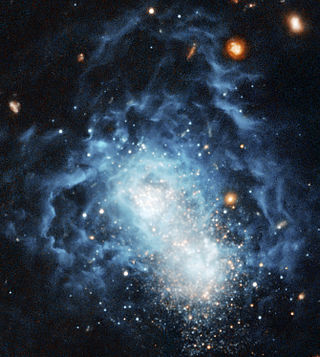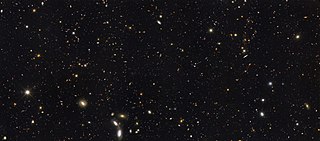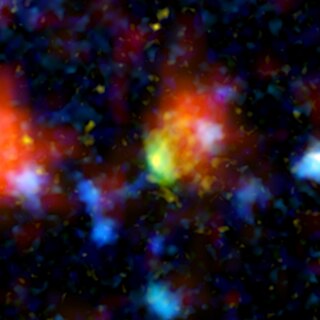
A galaxy is a system of stars, stellar remnants, interstellar gas, dust, and dark matter bound together by gravity. The word is derived from the Greek galaxias (γαλαξίας), literally 'milky', a reference to the Milky Way galaxy that contains the Solar System. Galaxies, averaging an estimated 100 million stars, range in size from dwarfs with less than a thousand stars, to the largest galaxies known – supergiants with one hundred trillion stars, each orbiting its galaxy's center of mass. Most of the mass in a typical galaxy is in the form of dark matter, with only a few percent of that mass visible in the form of stars and nebulae. Supermassive black holes are a common feature at the centres of galaxies.

The Hubble Space Telescope is a space telescope that was launched into low Earth orbit in 1990 and remains in operation. It was not the first space telescope, but it is one of the largest and most versatile, renowned as a vital research tool and as a public relations boon for astronomy. The Hubble telescope is named after astronomer Edwin Hubble and is one of NASA's Great Observatories. The Space Telescope Science Institute (STScI) selects Hubble's targets and processes the resulting data, while the Goddard Space Flight Center (GSFC) controls the spacecraft.

A galaxy cluster, or a cluster of galaxies, is a structure that consists of anywhere from hundreds to thousands of galaxies that are bound together by gravity, with typical masses ranging from 1014 to 1015 solar masses. They are the second-largest known gravitationally bound structures in the universe after some superclusters (of which only one, the Shapley Supercluster, is known to be bound). They were believed to be the largest known structures in the universe until the 1980s, when superclusters were discovered. One of the key features of clusters is the intracluster medium (ICM). The ICM consists of heated gas between the galaxies and has a peak temperature between 2–15 keV that is dependent on the total mass of the cluster. Galaxy clusters should not be confused with galactic clusters (also known as open clusters), which are star clusters within galaxies, or with globular clusters, which typically orbit galaxies. Small aggregates of galaxies are referred to as galaxy groups rather than clusters of galaxies. The galaxy groups and clusters can themselves cluster together to form superclusters.

The Hubble Deep Field (HDF) is an image of a small region in the constellation Ursa Major, constructed from a series of observations by the Hubble Space Telescope. It covers an area about 2.6 arcminutes on a side, about one 24-millionth of the whole sky, which is equivalent in angular size to a tennis ball at a distance of 100 metres. The image was assembled from 342 separate exposures taken with the Space Telescope's Wide Field and Planetary Camera 2 over ten consecutive days between December 18 and 28, 1995.

The Spitzer Space Telescope, formerly the Space Infrared Telescope Facility (SIRTF), is an infrared space telescope launched in 2003, that was deactivated when operations ended on 30 January 2020. Spitzer was the third space telescope dedicated to infrared astronomy, following IRAS (1983) and ISO (1995–1998). It was the first spacecraft to use an Earth-trailing orbit, later used by the Kepler planet-finder.

A starburst galaxy is one undergoing an exceptionally high rate of star formation, as compared to the long-term average rate of star formation in the galaxy, or the star formation rate observed in most other galaxies.

The James Webb Space Telescope (JWST) is a space telescope designed to conduct infrared astronomy. Its high-resolution and high-sensitivity instruments allow it to view objects too old, distant, or faint for the Hubble Space Telescope. This enables investigations across many fields of astronomy and cosmology, such as observation of the first stars and the formation of the first galaxies, and detailed atmospheric characterization of potentially habitable exoplanets.

Galaxy Evolution Explorer was a NASA orbiting space telescope designed to observe the universe in ultraviolet wavelengths to measure the history of star formation in the universe. In addition to paving the way for future ultraviolet missions, the space telescope allowed astronomers to uncover mysteries about the early universe and how it evolved, as well as better characterize phenomena like black holes and dark matter. The mission was extended three times over a period of 10 years before it was decommissioned in June 2013. GALEX was launched on 28 April 2003 and decommissioned in June 2013.

Leo I is a dwarf spheroidal galaxy in the constellation Leo. At about 820,000 light-years distant, it is a member of the Local Group of galaxies and is thought to be one of the most distant satellites of the Milky Way galaxy. It was discovered in 1950 by Albert George Wilson on photographic plates of the National Geographic Society – Palomar Observatory Sky Survey, which were taken with the 48-inch Schmidt camera at Palomar Observatory.

I Zwicky 18 is a blue compact dwarf galaxy located about 59 million light years away in the constellation Ursa Major. The galaxy was first identified by Swiss astronomer Fritz Zwicky in a 1930s photographic survey of galaxies.

The Great Observatories Origins Deep Survey, or GOODS, is an astronomical survey combining deep observations from three of NASA's Great Observatories: the Hubble Space Telescope, the Spitzer Space Telescope, and the Chandra X-ray Observatory, along with data from other space-based telescopes, such as XMM Newton, and some of the world's most powerful ground-based telescopes.

The Baby Boom Galaxy is a starburst galaxy located about 12.477 billion light years away. Discovered by NASA's Spitzer Science Center at the California Institute of Technology, the galaxy is the record holder for the brightest starburst galaxy in the very distant universe, with brightness being a measure of its extreme star-formation rate. The Baby Boom Galaxy has been nicknamed "the extreme stellar machine" because it is seen producing stars at a rate of up to 4,000 per year. The Milky Way galaxy in which Earth resides turns out an average of just 10 stars per year.

El Gordo is the largest distant galaxy cluster observed at its distance or beyond, as of 2011. As of 2014, it held the record for being the largest distant galaxy cluster to have been discovered with a mass of slightly less than three quadrillion solar masses although later its mass was reduced to about 2.1 quadrillion solar masses with a 10% uncertainty. It was found by NASA's Chandra X-ray Observatory, the Atacama Cosmology Telescope and the European Southern Observatory's Very Large Telescope.

The Phoenix Cluster is a massive, Abell class type I galaxy cluster located at its namesake, southern constellation of Phoenix. It was initially detected in 2010 during a 2,500 square degree survey of the southern sky using the Sunyaev–Zeldovich effect by the South Pole Telescope collaboration. It is one of the most massive galaxy clusters known, with the mass on the order of 2×1015M☉, and is the most luminous X-ray cluster discovered, producing more X-rays than any other known massive cluster. It is located at a comoving distance of 8.61 billion light-years from Earth. About 42 member galaxies were identified and currently listed in the SIMBAD Astronomical Database, though the real number may be as high as 1,000.

ASW0009io9 (9io9) is a gravitationally lensed system of two galaxies. The nearer galaxy is approximately 2 billion light-years (610 Mpc) from Earth and is designated SDSS J020941.27+001558.4, while the lensed galaxy is 10 billion light-years (3.1 Gpc) distant and is designated ASW0009io9. It was discovered in January 2014 by a group of citizen scientists, while classifying images on the website Spacewarps.org. The discovery was announced on the BBC television programme Stargazing Live.
GOODS-N-774 also called "Sparky", is a distant early galaxy which is in the process of core formation. The galaxy is massive and extremely compact, forming stars furiously. It is thought to be on its way to becoming a giant elliptical galaxy. This galaxy was discovered in 2014, and is some 11 billion light years distant. In the sky, it is located in the constellation of Ursa Major. It is the first discovered galaxy in this stage of giant galaxy formation.

Origins Space Telescope (Origins) is a concept study for a far-infrared survey space telescope mission. A preliminary concept in pre-formulation, it was presented to the United States Decadal Survey in 2019 for a possible selection to NASA's large strategic science missions. Origins would provide an array of new tools for studying star formation and the energetics and physical state of the interstellar medium within the Milky Way using infrared radiation and new spectroscopic capabilities.

HD1 is a proposed high-redshift galaxy, which is considered to be one of the earliest and most distant known galaxies yet identified in the observable universe. The galaxy, with an estimated redshift of approximately z = 13.27, is seen as it was about 324 million years after the Big Bang, which was 13.787 billion years ago. It has a light-travel distance of 13.463 billion light-years from Earth, and, due to the expansion of the universe, a present proper distance of 33.288 billion light-years.

Webb's First Deep Field is the first operational image taken by the James Webb Space Telescope (JWST). The deep-field photograph, which covers a tiny area of sky visible from the Southern Hemisphere, is centered on SMACS 0723, a galaxy cluster in the constellation of Volans. Thousands of galaxies are visible in the image, some as old as 13 billion years. It is the highest-resolution image of the early universe ever taken. Captured by the telescope's Near-Infrared Camera (NIRCam), the image was revealed to the public by NASA on 11 July 2022.



















